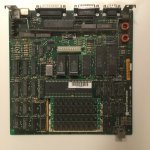CompaqMac
Member
Hello,
I’m new around here and new to Compact Macintoshes.
I’m not sure if anyone is interested, but here’s a pic of my Macintosh Plus logic board with a 16Mhz Brainstorm accelerator. I like this setup because it will allow me to run a beige floppy-only setup, but have some decent performance.
The logic board pictured below is out of a Macintosh Plus 1MB (beige) from early 1987.
At some point, I’d like to get an SE/30 and maybe another fixer upper Mac Plus to do some mods on.
I really enjoy what I’ve read on this board so far, and I look forward to exchanging ideas and information about these iconic machines.

I’m new around here and new to Compact Macintoshes.
I’m not sure if anyone is interested, but here’s a pic of my Macintosh Plus logic board with a 16Mhz Brainstorm accelerator. I like this setup because it will allow me to run a beige floppy-only setup, but have some decent performance.
The logic board pictured below is out of a Macintosh Plus 1MB (beige) from early 1987.
At some point, I’d like to get an SE/30 and maybe another fixer upper Mac Plus to do some mods on.
I really enjoy what I’ve read on this board so far, and I look forward to exchanging ideas and information about these iconic machines.

Last edited by a moderator:
